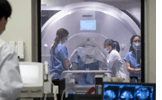Innovation
Focused U/S used safely to deliver meds to brain
September 14, 2022
 TORONTO – A team of researchers from Sunnybrook Health Sciences Centre and University Health Network (UHN) are the first in the world to demonstrate that focused ultrasound technology can safely be used to deliver a therapeutic to targeted brain regions in patients with Parkinson’s disease (PD). The leading-edge study has been published in “Movement Disorders”.
TORONTO – A team of researchers from Sunnybrook Health Sciences Centre and University Health Network (UHN) are the first in the world to demonstrate that focused ultrasound technology can safely be used to deliver a therapeutic to targeted brain regions in patients with Parkinson’s disease (PD). The leading-edge study has been published in “Movement Disorders”.
“Our early findings are an exciting and critical first step in less invasive direct-to-brain delivery of therapeutics to key areas of the brain important in the development and progression of Parkinson’s disease,” says Dr. Nir Lipsman, the study’s co-principal investigator and director of Sunnybrook’s Harquail Centre for Neuromodulation. “Current management strategies for Parkinson’s include medications and more invasive neurosurgery. Focused ultrasound is a less invasive, targeted approach that could change the way brain disorders are treated in the future.”
Low intensity MRI-guided focused ultrasound technology uses ultrasound waves to breach the blood-brain barrier, a layer of cells that protects the brain from toxins but can also block potentially helpful medications from getting where they need to go. The opening in the barrier, which closes within hours of the procedure, allows the therapy to pass and reach targeted brain region with millimeter accuracy.
Typically, treatments are unable to cross the blood-brain barrier because compounds are too large. In some cases, open brain surgery is required to help manage PD symptoms.
There is currently no cure for Parkinson’s, which is a common and progressive brain disorder that causes difficulties with movement and numerous disabling symptoms which dramatically impact a patient’s quality of life. Symptoms vary, and can progress at a different rate for each individual.
Study researchers investigated the delivery of an enzyme, glucocerebrosidase, to the putamen which is a key structure in the brain related to movement. Glucocerebrosidase may help to prevent buildup of the protein alpha-synuclein, a key indicator of PD that leads to unhealthy brain cells and neurodegeneration. In Parkinson’s, the enzyme can be defective and result in PD symptoms. Enzyme replacement therapy could be one approach to reduce or prevent neurodegeneration in PD.
The Phase I trial included four patients diagnosed with early-stage Parkinson’s disease with an average age of 54 years. Participants received three doses of the therapeutic and application of focused ultrasound every two weeks to the side of the brain most affected by the disease. They were followed for three- and six months.
“The Phase I trial offered a hint of potential improvement in symptoms following treatment but this requires further study. Any side effects, such as involuntary movements, were only temporary, and none were severe,” says Dr. Lorraine Kalia, co-principal investigator and a neurologist and senior scientist at the Krembil Brain Institute, part of UHN. “It is still very early in the research, but with our first-in-the-world study findings, we are making much needed progress in the development of innovative treatments for people with Parkinson’s disease.”
The Sunnybrook and UHN researchers have launched a Phase I/II clinical trial continuing the team’s investigation.
“The upcoming trial will further explore low intensity MRI-guided focused ultrasound and targeting enzyme replacement therapy to both sides of the brain. The ultimate goal is to improve the delivery of therapeutics to the brain with the hope of improved symptoms or slowed progression of Parkinson’s disease,” says Dr. Suneil Kalia, co-principal investigator and a neurosurgeon and scientist at UHN.
“There is robust data in both preclinical and clinical studies demonstrating that glucocerebrosidase replacement is a promising disease-modifying therapy in Parkinson’s disease. The next step is to better understand the biologic effects of the treatment with further research,” says Dr. Ying Meng, the study’s first author and neurosurgery resident at Sunnybrook.
A key driver of Sunnybrook’s research in focused ultrasound is philanthropic investment. This study is funded by the Focused Ultrasound Foundation, The Harquail Family, and INSIGHTEC. UHN research is supported by the Krembil Foundation and UHN Foundation.
